Condensed matter with fermions in an optical lattice
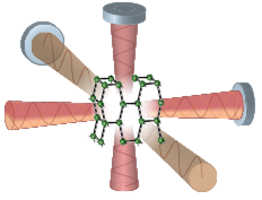 In the lattice experiment we study the properties of a degenerate Fermi gas of potassium atoms loaded into an artificial crystal of light. This system behaves very similarly to the gas of electrons in a solid, the electrons being replaced by fermionic atoms, and the ion crystalline structure by the optical lattice. It is indeed described by one of the key models of condensed matter physics, the Fermi-Hubbard model, which contains extremely rich phenomena: metallic and insulating phases, magnetic order, superconductivity... We can thus study the fascinating physics of strongly correlated materials in a clean and highly controlled environment, where all relevant parameters (interaction strength, lattice depth, lattice geometry and filling) can be precisely adjusted. Our recent research is outlined below, and has mainly focussed on the study of strongly correlated fermionic systems in static and recently also periodically driven lattices.
In the lattice experiment we study the properties of a degenerate Fermi gas of potassium atoms loaded into an artificial crystal of light. This system behaves very similarly to the gas of electrons in a solid, the electrons being replaced by fermionic atoms, and the ion crystalline structure by the optical lattice. It is indeed described by one of the key models of condensed matter physics, the Fermi-Hubbard model, which contains extremely rich phenomena: metallic and insulating phases, magnetic order, superconductivity... We can thus study the fascinating physics of strongly correlated materials in a clean and highly controlled environment, where all relevant parameters (interaction strength, lattice depth, lattice geometry and filling) can be precisely adjusted. Our recent research is outlined below, and has mainly focussed on the study of strongly correlated fermionic systems in static and recently also periodically driven lattices.
One intriguing example of strongly correlated states that we have experimentally observed is the Mott insulator, which occurs for a system with a half-filled band. There, a strong repulsive interaction between the fermions can lead to a localization of the atoms on the lattice sites and drive a crossover from a metallic to an insulating state. Furthermore, despite the strong localization of the individual atoms, higher order tunnelling processes mediate an effective spin-spin interaction. Consequently, magnetic correlations form as the temperature decreases, which we have investigated as a function of the underlying lattice geometry using our tuneable setup.
In recent years, we have extended our area of interest to include periodically driven systems. The additional degrees of freedom provided by the drive allow to access new states of matter. Indeed, the slow dynamics of the system may be described by an effective Hamiltonian, which can contain terms inaccessible to static implementations. For example, it is possible to create Bloch bands with a non-trivial topology, which we have successfully observed by realising the Haldane model, a lattice analogue of the quantum Hall effect. We have also applied this technique, known as Floquet engineering, to strongly interacting many-body systems, and demonstrated coherent control of the local magnetic order.
Reversal of quantized Hall drifts at noninteracting and interacting topological boundaries
18 April 2024
 In quantum Hall systems, a bulk current can be reflected off the system boundary through a gapless edge current. Although this phenomenon is tricky to study in electronic materials, it is more accessible in “artificial” quantum Hall systems. Here, we use ultracold potassium-40 atoms to engineer an equivalent of a quantum Hall system featuring one real and one synthetic dimension. The atoms were pumped toward the system’s edge, reversing direction at the location of the topological boundary. Nonzero repulsive Hubbard interactions led to the emergence of an additional edge in the system through a mechanism in which pairs of fermions are split.
In quantum Hall systems, a bulk current can be reflected off the system boundary through a gapless edge current. Although this phenomenon is tricky to study in electronic materials, it is more accessible in “artificial” quantum Hall systems. Here, we use ultracold potassium-40 atoms to engineer an equivalent of a quantum Hall system featuring one real and one synthetic dimension. The atoms were pumped toward the system’s edge, reversing direction at the location of the topological boundary. Nonzero repulsive Hubbard interactions led to the emergence of an additional edge in the system through a mechanism in which pairs of fermions are split.
Read the paper (open access): Science, 193602 (2019)
Read the preprint: arXiv:2301.03583
Read the ETHZ press release: ETHZ press release
Quantization and its breakdown in a Hubbard–Thouless pump
24 July 2023
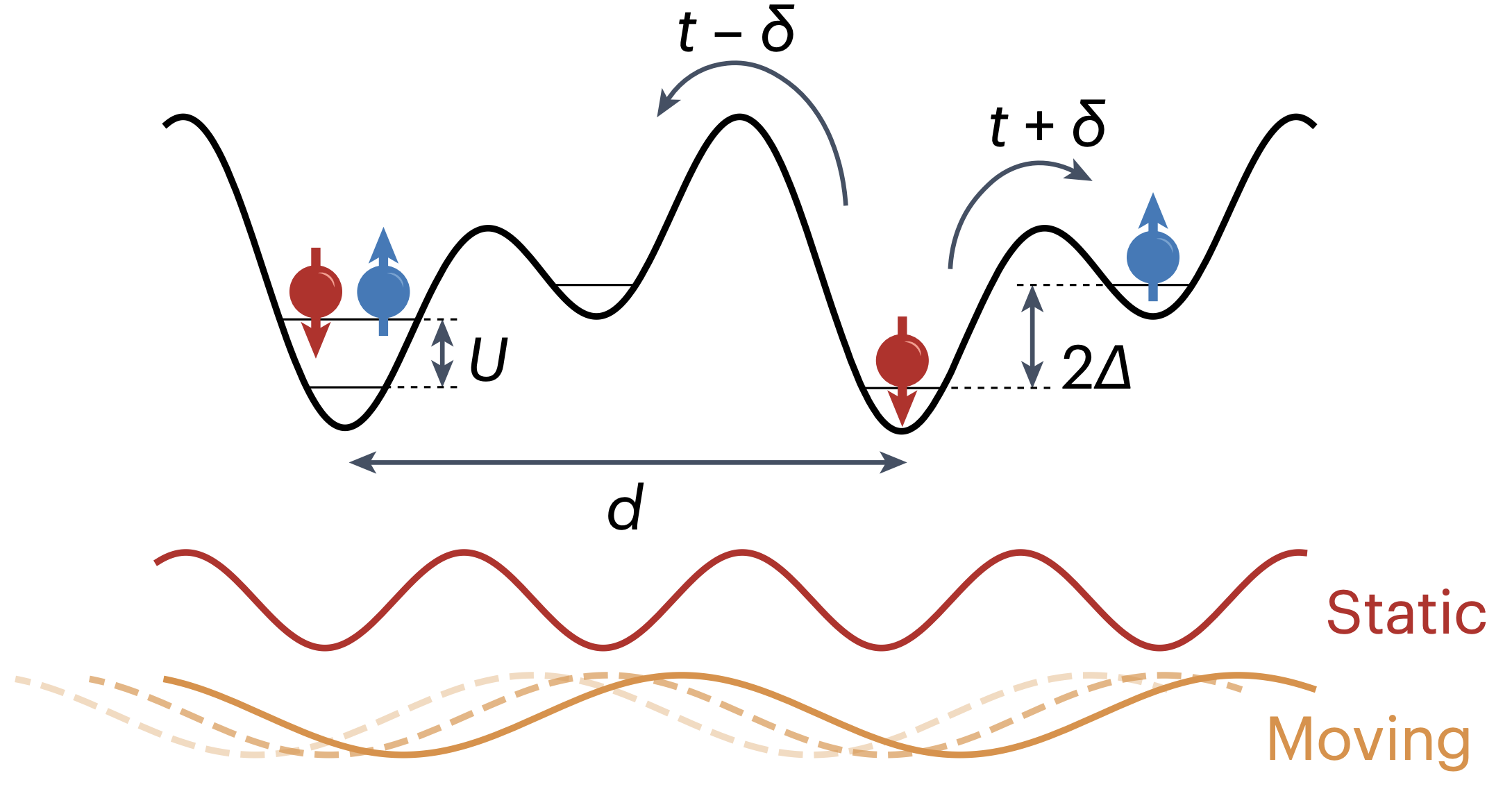 The presence of interparticle interactions can affect the topology of a material, invalidating the idealized formulation in terms of Bloch waves. Despite pioneering experiments in different platforms, the study of topological matter under variations in interparticle interactions has proven challenging. Here we experimentally realize a topological Thouless pump with fully tuneable Hubbard interactions in an optical lattice and observe regimes with robust pumping, as well as an interaction-induced breakdown. We confirm the pump’s robustness against interactions that are smaller than the protecting gap for both repulsive and attractive interactions. Furthermore, we identify that bound pairs of fermions are responsible for quantized transport at strongly attractive interactions. However, for strong repulsive interactions, topological pumping breaks down, but we show how to reinstate it by modifying the pump trajectory.
The presence of interparticle interactions can affect the topology of a material, invalidating the idealized formulation in terms of Bloch waves. Despite pioneering experiments in different platforms, the study of topological matter under variations in interparticle interactions has proven challenging. Here we experimentally realize a topological Thouless pump with fully tuneable Hubbard interactions in an optical lattice and observe regimes with robust pumping, as well as an interaction-induced breakdown. We confirm the pump’s robustness against interactions that are smaller than the protecting gap for both repulsive and attractive interactions. Furthermore, we identify that bound pairs of fermions are responsible for quantized transport at strongly attractive interactions. However, for strong repulsive interactions, topological pumping breaks down, but we show how to reinstate it by modifying the pump trajectory.
Read the paper: Nat. Phys. 19, 1471–1475
Read the preprint: arXiv:2204.06561
Topological Pumping in a Floquet-Bloch Band
29 July 2022
 Constructing new topological materials is of vital interest for the development of robust quantum applications. However, engineering such materials often causes technological overhead. Simplifying the experimental requirements has been addressed on a conceptual level—by proposing to combine simple lattice structures with Floquet engineering—but there has been no experimental implementation. Here, we demonstrate topological pumping in a Floquet-Bloch band using a plain sinusoidal lattice potential and two-tone driving with frequencies ω and 2ω. We adiabatically prepare a near-insulating Floquet band of ultracold fermions via a frequency chirp, which avoids gap closings en route from trivial to topological bands. Subsequently, we induce topological pumping by slowly cycling the amplitude and the phase of the 2ω drive. Our system is well described by an effective Shockley model, establishing a novel paradigm to engineer topological matter from simple underlying lattice geometries.
Constructing new topological materials is of vital interest for the development of robust quantum applications. However, engineering such materials often causes technological overhead. Simplifying the experimental requirements has been addressed on a conceptual level—by proposing to combine simple lattice structures with Floquet engineering—but there has been no experimental implementation. Here, we demonstrate topological pumping in a Floquet-Bloch band using a plain sinusoidal lattice potential and two-tone driving with frequencies ω and 2ω. We adiabatically prepare a near-insulating Floquet band of ultracold fermions via a frequency chirp, which avoids gap closings en route from trivial to topological bands. Subsequently, we induce topological pumping by slowly cycling the amplitude and the phase of the 2ω drive. Our system is well described by an effective Shockley model, establishing a novel paradigm to engineer topological matter from simple underlying lattice geometries.
Read the paper: PRL 129, 053201
Read the preprint: arXiv:2112.12788
Advanced Floquet Engineering with two-frequency modulation for Band Structure Control
28 January 2022
 Floquet engineering, harnessing periodic drives to create novel Hamiltonians, faces challenges in controlling photon absorption and dissipative coupling to higher-lying modes. We address this by introducing two-path quantum interference with a secondary modulation at twice the fundamental frequency, significantly suppressing dissipation in optical lattices. Meanwhile, two-frequency phase modulation asymmetrically hybridizes bands in one-dimensional lattices, offering precise control over individual band gaps. This combination enables enhanced control over low-temperature phases and band topology in interacting Floquet systems.
Floquet engineering, harnessing periodic drives to create novel Hamiltonians, faces challenges in controlling photon absorption and dissipative coupling to higher-lying modes. We address this by introducing two-path quantum interference with a secondary modulation at twice the fundamental frequency, significantly suppressing dissipation in optical lattices. Meanwhile, two-frequency phase modulation asymmetrically hybridizes bands in one-dimensional lattices, offering precise control over individual band gaps. This combination enables enhanced control over low-temperature phases and band topology in interacting Floquet systems.
Read the paper: Phys. Rev. X 11, 011057
Read the paper: Phys. Rev. Res 4, 013056
Read the preprint: arXiv:2003.05937
Read the preprint: arXiv:2110.08251
Quantum Simulation Meets Nonequilibrium Dynamical Mean Field Theory: Exploring the Periodically Driven, Strongly Correlated Fermi-Hubbard Model
8 November 2019
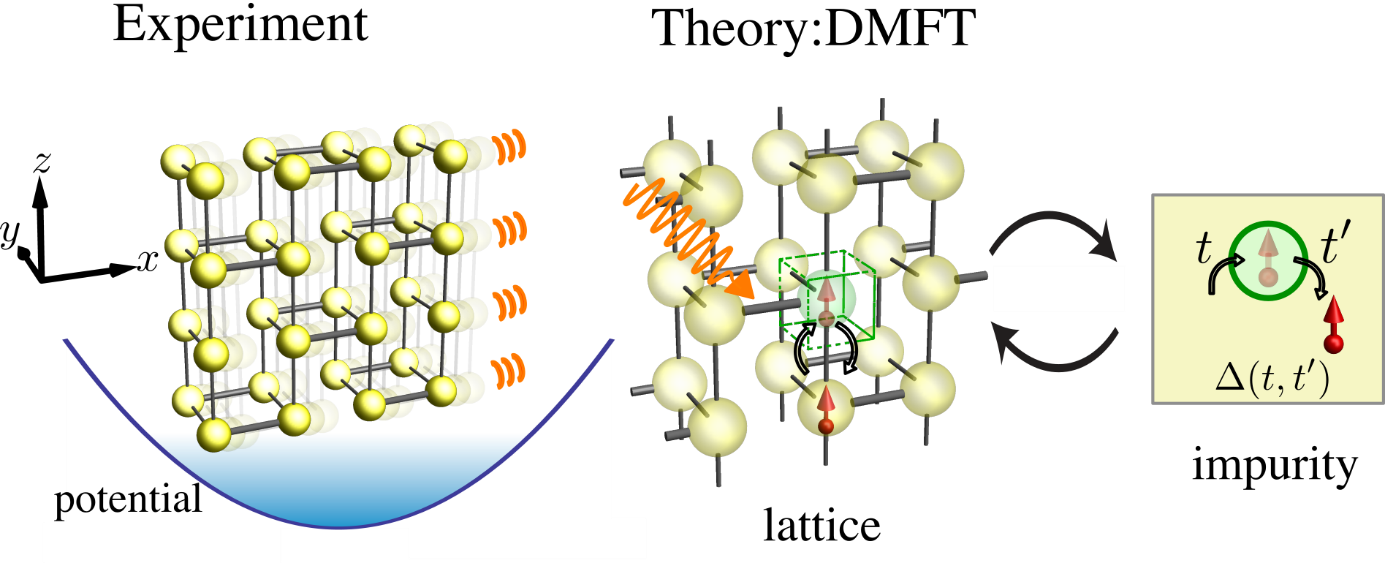 The periodically driven Fermi Hubbard model is used to study the physics of Floquet engineered
strongly correlated matter. In close collaboration with Yuta Murakami and Philipp Werner from the
University of Fribourg as well as Martin Eckstein from the University of Erlangen-Nürnberg, we
combine calculations of nonequilibrium dynamical mean field theory (DMFT) with experiments on
fermions in optical lattices to explore the physics happening in the regimes of strongly driven
interacting systems. For off-resonant driving, the range of validity of a description in terms of an
effective static Hamiltonian is determined and its breakdown due to energy absorption close to
resonance is demonstrated. For near-resonant driving, we investigate the response to a change in
driving amplitude and discover an asymmetric excitation spectrum with respect to the detuning. In
general, we find good agreement between experiment and theory, which cross-validates the
experimental and numerical approaches in a strongly-correlated nonequilibrium system.
The periodically driven Fermi Hubbard model is used to study the physics of Floquet engineered
strongly correlated matter. In close collaboration with Yuta Murakami and Philipp Werner from the
University of Fribourg as well as Martin Eckstein from the University of Erlangen-Nürnberg, we
combine calculations of nonequilibrium dynamical mean field theory (DMFT) with experiments on
fermions in optical lattices to explore the physics happening in the regimes of strongly driven
interacting systems. For off-resonant driving, the range of validity of a description in terms of an
effective static Hamiltonian is determined and its breakdown due to energy absorption close to
resonance is demonstrated. For near-resonant driving, we investigate the response to a change in
driving amplitude and discover an asymmetric excitation spectrum with respect to the detuning. In
general, we find good agreement between experiment and theory, which cross-validates the
experimental and numerical approaches in a strongly-correlated nonequilibrium system.
Read the paper: PRL 123, 193602 (2019)
Read the preprint: arXiv:1811.12826
Realization of density-dependent Peierls phases to engineer quantized gauge fields coupled to ultracold matter
19 August 2019
 Gauge fields that appear in models of high-energy and condensed matter physics are dynamical quantum degrees of freedom due to their coupling to matter fields. Since the dynamics of these strongly correlated systems is hard to compute, it was proposed to implement this basic coupling mechanism in quantum simulation platforms with the ultimate goal to emulate lattice gauge theories.
Gauge fields that appear in models of high-energy and condensed matter physics are dynamical quantum degrees of freedom due to their coupling to matter fields. Since the dynamics of these strongly correlated systems is hard to compute, it was proposed to implement this basic coupling mechanism in quantum simulation platforms with the ultimate goal to emulate lattice gauge theories.
We recently realized the fundamental ingredient for a density-dependent gauge field acting on ultracold fermions in an optical lattice by engineering non-trivial Peierls phases that depend on the site occupations. In our paper, we propose and implement a Floquet scheme that relies on breaking time-reversal symmetry by driving the lattice simultaneously at two frequencies which are resonant with the onsite interactions. This induces density-assisted tunnelling processes that are controllable in amplitude and phase. We demonstrate techniques in a Hubbard dimer to quantify the amplitude and to directly measure the Peierls phase with respect to the single-particle hopping. The tunnel coupling features two distinct regimes as a function of the modulation amplitudes, which can be characterized by a Z2-invariant. Moreover, we provide a full tomography of the winding structure of the Peierls phase around a Dirac point that appears in the driving parameter space.
Read the ETHZ press release: Towards an ‘orrery’ for quantum gauge theory
Read the paper: Nature Physics (2019) (direct pdf link)
Read the preprint: arXiv:1812.05895
Floquet Dynamics in Driven Fermi-Hubbard Systems
7 December 2018
 The application of a periodic drive to a quantum system can generate novel effects, which can be described by an effectively static Hamiltonian picture. However, the presence of the periodic modulation can also limit the implementation of interesting many-body states because integrability breaking terms such as interactions lead to heating the system to infinite temperature for long timescales.
The application of a periodic drive to a quantum system can generate novel effects, which can be described by an effectively static Hamiltonian picture. However, the presence of the periodic modulation can also limit the implementation of interesting many-body states because integrability breaking terms such as interactions lead to heating the system to infinite temperature for long timescales.
We study the dynamics and timescales of a periodically driven Fermi-Hubbard model in a three-dimensional hexagonal lattice. The evolution of the Floquet many-body state is analyzed by comparing it to an equivalent implementation in undriven systems. The dynamics of double occupancies for the near- and off-resonant driving regime indicate that the effective Hamiltonian picture is valid for several orders of magnitude in modulation time. Furthermore, we show that driving a hexagonal lattice compared to a simple cubic lattice allows us to modulate the system up to 1 s, corresponding to hundreds of tunneling times, with only minor atom loss. Here, driving at a frequency close to the interaction energy does not introduce resonant features to the atom loss.
Read the paper: PRL 121, 23 (2018)
Read the preprint: arXiv:1808.00506
Enhancement and sign change of magnetic correlations in a driven quantum many-body system
26 January 2018
 Periodic driving of an interacting quantum system offers the possibility to coherently control the properties of the underlying many-body state and to thereby realize new phases of matter. In solid state experiments, ultrashort laser pulses are employed to manipulate the charge order as well as to control magnetic and superconducting properties of materials. At the same time, continuous driving has been used in cold atom experiments to engineer novel effective Floquet-Hamiltonians which feature for example a topological band structure.
Periodic driving of an interacting quantum system offers the possibility to coherently control the properties of the underlying many-body state and to thereby realize new phases of matter. In solid state experiments, ultrashort laser pulses are employed to manipulate the charge order as well as to control magnetic and superconducting properties of materials. At the same time, continuous driving has been used in cold atom experiments to engineer novel effective Floquet-Hamiltonians which feature for example a topological band structure.
We have recently realized a strongly interacting Fermi gas in a periodically modulated hexagonal lattice and investigated its charge and magnetic properties. We first demonstrate that in the high-frequency driving regime, the effective description of the many-body system by a renormalized tunnelling amplitude remains valid by comparing our results to an equivalent static system. When modulating the lattice at a frequency close to the interaction energy, we show that antiferromagnetic spin-spin correlations can be enhanced or even switched to ferromagnetic ordering. Our observations can be explained by a microscopic model, in which the particle tunnelling and magnetic exchange energies can be controlled independently. In combination with the observed sufficiently long lifetimes of correlations in this system, Floquet engineering thus constitutes an alternative route to experimentally investigate unconventional pairing.
Read the paper: Nature 553, 481-485 (2018)
Read the preprint: arXiv:1708.06751
See also: ETH press release
Controlling the Floquet state population and observing micromotion in a periodically driven two-body quantum system
1 November 2017
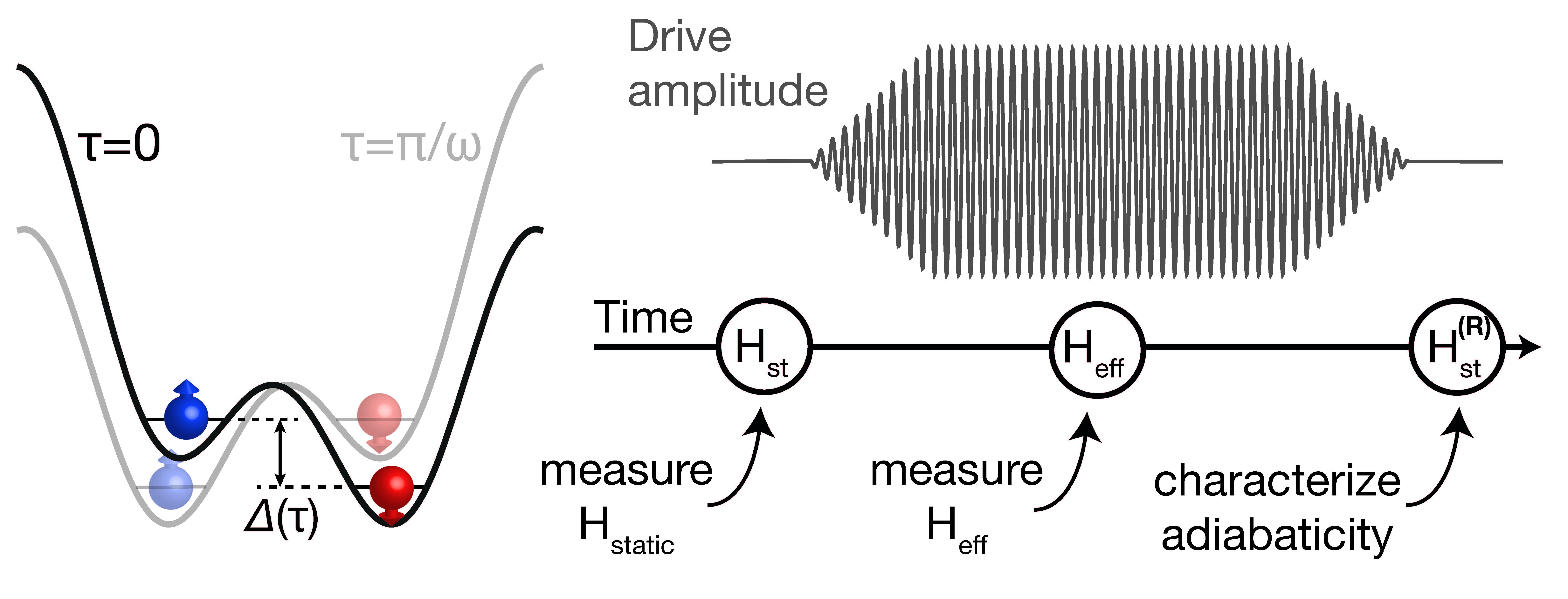 Periodic driving of quantum systems promises the implementation of a large variety of novel
quantum states. However, their preparation and measurement remains challenging, in
particular in the presence of interactions and for a near-resonant modulation. We address
these aspects in a model system consisting of two interacting fermions in a periodically
driven array of double wells created by an optical lattice. We measure the singlet and triplet
fractions and the double occupancy of the Floquet states and analyze their behavior as a
function of the interaction strength in the high- and low-frequency regimes. We
demonstrate full control of the Floquet state population and find suitable ramping protocols
and time scales that adiabatically connect the initial ground state to different targeted
Floquet states. The micromotion that exactly describes the time evolution of the system
within one driving cycle is observed. Additionally, we provide an analytic description of the
model and compare it to numerical simulations.
Periodic driving of quantum systems promises the implementation of a large variety of novel
quantum states. However, their preparation and measurement remains challenging, in
particular in the presence of interactions and for a near-resonant modulation. We address
these aspects in a model system consisting of two interacting fermions in a periodically
driven array of double wells created by an optical lattice. We measure the singlet and triplet
fractions and the double occupancy of the Floquet states and analyze their behavior as a
function of the interaction strength in the high- and low-frequency regimes. We
demonstrate full control of the Floquet state population and find suitable ramping protocols
and time scales that adiabatically connect the initial ground state to different targeted
Floquet states. The micromotion that exactly describes the time evolution of the system
within one driving cycle is observed. Additionally, we provide an analytic description of the
model and compare it to numerical simulations.
Read the paper: Physical Review A 96, 053602 (2017)
Read the preprint: arXiv:1703.07767
Creating topological interfaces and detecting chiral edge modes in a two-dimensional optical lattice
6 October 2016
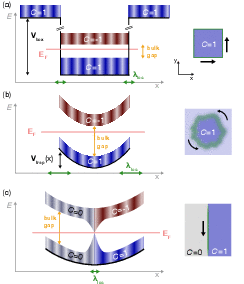 An exciting feature of topological states of matter is the presence of robust edge modes, located at the interface between two topologically distinct regions. This is most often realised at the boundary between the system of interest and the vacuum. However, such a configuration is not well suited for an experimental observation with cold atoms systems, as the edge is smeared out by the relatively smooth (harmonic) confining potential. In a recent collaboration with N. Goldman, we propose instead to engineer an interface between two topologically distinct phases of the Haldane model (see Jotzu et al). We present two realistic experimental configurations, which lead to linear and radial-symmetric topological interfaces, which both allow one to significantly reduce the effects of external confinement on topological edge properties. Furthermore, the versatility of our method opens the possibility of tuning the position, the localization length, and the chirality of the edge modes, through simple adjustments of the lattice potentials. In order to demonstrate the unique detectability offered by engineered interfaces, we numerically investigate the time evolution of wave packets, indicating how topological transport unambiguously manifests itself within the lattice. Finally, we analyze the effects of disorder on the dynamics of chiral and nonchiral states present in the system. Interestingly, engineered disorder is shown to provide a powerful tool for the detection of topological edge modes in cold-atom setups.
An exciting feature of topological states of matter is the presence of robust edge modes, located at the interface between two topologically distinct regions. This is most often realised at the boundary between the system of interest and the vacuum. However, such a configuration is not well suited for an experimental observation with cold atoms systems, as the edge is smeared out by the relatively smooth (harmonic) confining potential. In a recent collaboration with N. Goldman, we propose instead to engineer an interface between two topologically distinct phases of the Haldane model (see Jotzu et al). We present two realistic experimental configurations, which lead to linear and radial-symmetric topological interfaces, which both allow one to significantly reduce the effects of external confinement on topological edge properties. Furthermore, the versatility of our method opens the possibility of tuning the position, the localization length, and the chirality of the edge modes, through simple adjustments of the lattice potentials. In order to demonstrate the unique detectability offered by engineered interfaces, we numerically investigate the time evolution of wave packets, indicating how topological transport unambiguously manifests itself within the lattice. Finally, we analyze the effects of disorder on the dynamics of chiral and nonchiral states present in the system. Interestingly, engineered disorder is shown to provide a powerful tool for the detection of topological edge modes in cold-atom setups.
Read the paper: Physical Review A 94, 043611 (2016)
Read the preprint: arXiv:1606.00015
Creation of spin-dependent lattices
13 August 2015
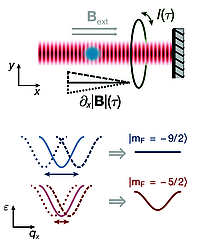 Periodically driving a system of ultracold fermionic atoms in an optical lattice allows for implementing a large variety of effective Hamiltonians through Floquet engineering. In our recent work we use a periodically modulated magnetic field gradient to create tunable spin-dependent optical lattices. Our method allows for freely tuning the relative amplitude and sign of the tunneling for different internal states. Thereby we experimentally realize spin-dependent effective Hamiltonians where one state can be localized in the lattice, while the other remains itinerant. For each spin state, the differing band structure can be characterized either by measuring the expansion of an atomic cloud in the lattice, or by a measurement of the effective mass through dipole oscillations. Furthermore, a systematic study in the Fermi-Hubbard regime shows negligible heating and long lifetimes in the driven system.
Periodically driving a system of ultracold fermionic atoms in an optical lattice allows for implementing a large variety of effective Hamiltonians through Floquet engineering. In our recent work we use a periodically modulated magnetic field gradient to create tunable spin-dependent optical lattices. Our method allows for freely tuning the relative amplitude and sign of the tunneling for different internal states. Thereby we experimentally realize spin-dependent effective Hamiltonians where one state can be localized in the lattice, while the other remains itinerant. For each spin state, the differing band structure can be characterized either by measuring the expansion of an atomic cloud in the lattice, or by a measurement of the effective mass through dipole oscillations. Furthermore, a systematic study in the Fermi-Hubbard regime shows negligible heating and long lifetimes in the driven system.
Read the paper: Physical Review Letters 115, 073002 (2015)
Read the preprint: arXiv:1504.05573
Formation and Dynamics of Antiferromagnetic Correlations in Tunable Optical Lattices
23 December 2015
 Following on the previous observation of short-range antiferromagnetic correlations in 1D chains (Greif et al), we have investigated the influence of the lattice geometry on the observed correlations. In the experiment, we can change the connectivity of sites, from one neighbour (dimerized lattice) to six neighbours (cubic lattice). We now observe correlations in all lattice geometries, which decrease as the connectivity is increased. This can be attributed both to quantum and thermal fluctuations. Furthermore, we are not restricted to a fixed connectivity, and can interpolate smoothly between one and the other. By measuring the correlations in a crossover between distinct geometries, we demonstrate an effective reduction of the dimensionality for our atom numbers and temperatures. We also investigate the formation and redistribution time of spin correlations by dynamically changing the lattice geometry and study the time evolution of the system.
Following on the previous observation of short-range antiferromagnetic correlations in 1D chains (Greif et al), we have investigated the influence of the lattice geometry on the observed correlations. In the experiment, we can change the connectivity of sites, from one neighbour (dimerized lattice) to six neighbours (cubic lattice). We now observe correlations in all lattice geometries, which decrease as the connectivity is increased. This can be attributed both to quantum and thermal fluctuations. Furthermore, we are not restricted to a fixed connectivity, and can interpolate smoothly between one and the other. By measuring the correlations in a crossover between distinct geometries, we demonstrate an effective reduction of the dimensionality for our atom numbers and temperatures. We also investigate the formation and redistribution time of spin correlations by dynamically changing the lattice geometry and study the time evolution of the system.
Read the paper: Physical Review Letters 115, 260401 (2015)
Read the preprint: arXiv:1509.00854
Exploring competing density order in the Ionic Hubbard model
10 September 2015
 The Ionic Hubbard model is a fundamental model that describes the competition between different density-ordered phases, which originate from the interplay of the underlying geometry and inter-particle interactions. Depending on the energy scales, it can feature a charge density wave ordered state or a Mott-insulating state. We realize the Ionic Hubbard model on our tunable optical lattice by loading an interacting Fermi gas into a honeycomb lattice with staggered energy offset on alternating sites. We use different experimental tools such as noise correlation measurements to characterize the different states of the system. In addition we characterize the staggered density order by measuring the double occupancy and the charge excitation spectrum. We show that the discovered excitation spectrum agrees well with a calculation of the kinetic energy response function.
The Ionic Hubbard model is a fundamental model that describes the competition between different density-ordered phases, which originate from the interplay of the underlying geometry and inter-particle interactions. Depending on the energy scales, it can feature a charge density wave ordered state or a Mott-insulating state. We realize the Ionic Hubbard model on our tunable optical lattice by loading an interacting Fermi gas into a honeycomb lattice with staggered energy offset on alternating sites. We use different experimental tools such as noise correlation measurements to characterize the different states of the system. In addition we characterize the staggered density order by measuring the double occupancy and the charge excitation spectrum. We show that the discovered excitation spectrum agrees well with a calculation of the kinetic energy response function.
Read the paper: Physical Review Letters 115, 115303 (2015)
Read the preprint: arXiv:1503.05549
Experimental realization of the Haldane model
11 November 2014
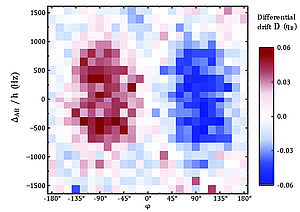 The tunable geometry optical lattice introduced in previous experiments offers a range of fascinating lattice geometries. In our latest experiment, we created an effective Hamiltonian realizing the Haldane model by periodically shaking the position of a honeycomb lattice.
The Haldane model is a paradigmatic example of a Hamiltonian featuring topologically distinct phases of matter. It describes a mechanism through which a quantum Hall effect can appear as an intrinsic property of a band-structure, rather than being caused by an external magnetic field.
In our experiment, we use a non-interacting Fermi gas to probe the topological properties of the lowest Bloch band and measure the analogue of a Hall current, characteristic of non-trivial topology. Furthermore, we identify the vanishing gap separating distinct topological regimes over the entire phase diagram.
By continuous tuning of the parameters of the Hamiltonian, we are able to dynamically change the topological nature of the system. Furthermore, we demonstrate that this approach can be extended to interacting systems, opening the possibility of realizing interacting topological states of matter.
The tunable geometry optical lattice introduced in previous experiments offers a range of fascinating lattice geometries. In our latest experiment, we created an effective Hamiltonian realizing the Haldane model by periodically shaking the position of a honeycomb lattice.
The Haldane model is a paradigmatic example of a Hamiltonian featuring topologically distinct phases of matter. It describes a mechanism through which a quantum Hall effect can appear as an intrinsic property of a band-structure, rather than being caused by an external magnetic field.
In our experiment, we use a non-interacting Fermi gas to probe the topological properties of the lowest Bloch band and measure the analogue of a Hall current, characteristic of non-trivial topology. Furthermore, we identify the vanishing gap separating distinct topological regimes over the entire phase diagram.
By continuous tuning of the parameters of the Hamiltonian, we are able to dynamically change the topological nature of the system. Furthermore, we demonstrate that this approach can be extended to interacting systems, opening the possibility of realizing interacting topological states of matter.
Read the paper: Nature 515, 237-240 (2014)
Read the preprint: arXiv:1406.7874
Thermodynamics and magnetic properties of the anisotropic 3D Hubbard model
9 April 2014
 In this work, we study the anisotropic 3D Hubbard model with increased nearest-neighbor tunneling amplitudes along one direction using the dynamical cluster approximation and compare to our recent experimental results on short-range magnetic correlations in the tunable-geometry optical lattice.
In agreement with the experiment, we find that the short-range spin correlations are significantly enhanced in the direction with stronger tunneling amplitudes. We characterize the system by examining the spin correlations beyond neighboring sites and determine the distribution of density, entropy, and spin correlation in the trapped system. We furthermore investigate the dependence of the critical entropy at the Néel transition on anisotropy.
In this work, we study the anisotropic 3D Hubbard model with increased nearest-neighbor tunneling amplitudes along one direction using the dynamical cluster approximation and compare to our recent experimental results on short-range magnetic correlations in the tunable-geometry optical lattice.
In agreement with the experiment, we find that the short-range spin correlations are significantly enhanced in the direction with stronger tunneling amplitudes. We characterize the system by examining the spin correlations beyond neighboring sites and determine the distribution of density, entropy, and spin correlation in the trapped system. We furthermore investigate the dependence of the critical entropy at the Néel transition on anisotropy.
Read the paper: Phys. Rev. Lett. 112, 115301 (2014) Erratum Phys. Rev. Lett. 112, 159903 (2014)
Read the preprint: arXiv:1309.7362
Graphene goes strong
9 November 2013
 An experiment, in which the interactions between atoms trapped in an artificial honeycomb lattice can be tuned over a broad range, introduces a versatile platform for exploring the physics of graphene.
Graphene, famously, has a number of remarkable properties, not least with a view to how electrons behave within the material. Many questions regarding the underlying physics, however, remain open. A fresh perspective has come in recent years through the study of engineered systems that share characteristic properties with graphene, but enable experiments in regimes not reachable in the natural material.
We have now accessed one of these platforms with a knob for tuning between qualitatively distinct phases. In our system, the role of the electrons is taken by cold atoms, which laser beams lock into a graphene-like lattice. With the aid of magnetic fields, we change the interactions between atoms from weak, as found in natural graphene, to strong, where a so-called Mott insulator emerges.
In previous implementations of "artificial graphene", the interaction strength has been fixed to one narrow regime. Our demonstration of a widely tunable system opens up an avenue to systematically studying graphene physics with strong interactions in situations where theories and numerical simulations today cannot deliver definite answers.
An experiment, in which the interactions between atoms trapped in an artificial honeycomb lattice can be tuned over a broad range, introduces a versatile platform for exploring the physics of graphene.
Graphene, famously, has a number of remarkable properties, not least with a view to how electrons behave within the material. Many questions regarding the underlying physics, however, remain open. A fresh perspective has come in recent years through the study of engineered systems that share characteristic properties with graphene, but enable experiments in regimes not reachable in the natural material.
We have now accessed one of these platforms with a knob for tuning between qualitatively distinct phases. In our system, the role of the electrons is taken by cold atoms, which laser beams lock into a graphene-like lattice. With the aid of magnetic fields, we change the interactions between atoms from weak, as found in natural graphene, to strong, where a so-called Mott insulator emerges.
In previous implementations of "artificial graphene", the interaction strength has been fixed to one narrow regime. Our demonstration of a widely tunable system opens up an avenue to systematically studying graphene physics with strong interactions in situations where theories and numerical simulations today cannot deliver definite answers.
Read the paper: Phys. Rev. Lett. 111, 185307 (2013)
Read the preprint: arXiv:1308.4401
Quantum magnetism of ultracold fermions in an optical lattice
13 December 2012
 We report on the observation of quantum magnetism of a Fermi gas in an optical lattice. The key to obtaining and detecting the short-range magnetic order is a tunable geometry optical lattice. When loading a low-temperature two-component gas with repulsive interactions into either a dimerized or anisotropic simple cubic lattice, we find magnetic correlations on neighbouring sites. The correlations manifest as an excess number of singlets as compared to triplets consisting of two atoms with opposite spins. For the anisotropic lattice, we determine the transverse spin correlator from the singlet-triplet imbalance and observe antiferromagnetic correlations along one spatial axis.
We report on the observation of quantum magnetism of a Fermi gas in an optical lattice. The key to obtaining and detecting the short-range magnetic order is a tunable geometry optical lattice. When loading a low-temperature two-component gas with repulsive interactions into either a dimerized or anisotropic simple cubic lattice, we find magnetic correlations on neighbouring sites. The correlations manifest as an excess number of singlets as compared to triplets consisting of two atoms with opposite spins. For the anisotropic lattice, we determine the transverse spin correlator from the singlet-triplet imbalance and observe antiferromagnetic correlations along one spatial axis.
Read the paper: Science 340, 1307 (2013)
Read the preprint: arXiv:1212.2634
Double transfer through Dirac points in a tunable honeycomb optical lattice
28 November 2012
 We report on Bloch-Zener oscillations of an ultracold Fermi gas in a tunable honeycomb lattice. The quasi-momentum distribution of the atoms is measured after sequentially passing through two Dirac points. We observe a double-peak feature in the transferred fraction to the second band, both as a function of the band gap at the Dirac points and the quasi-momentum of the trajectory. Our results are in good agreement with a simple analytical model based on two successive Landau-Zener transitions. Owing to the variation of the potential gradient over the cloud size, coherent Stückelberg oscillations are not visible in our measurements. This effect of the harmonic confinement is confirmed by a numerical simulation of the dynamics of a trapped 2D system.
We report on Bloch-Zener oscillations of an ultracold Fermi gas in a tunable honeycomb lattice. The quasi-momentum distribution of the atoms is measured after sequentially passing through two Dirac points. We observe a double-peak feature in the transferred fraction to the second band, both as a function of the band gap at the Dirac points and the quasi-momentum of the trajectory. Our results are in good agreement with a simple analytical model based on two successive Landau-Zener transitions. Owing to the variation of the potential gradient over the cloud size, coherent Stückelberg oscillations are not visible in our measurements. This effect of the harmonic confinement is confirmed by a numerical simulation of the dynamics of a trapped 2D system.
Read the paper: Eur. Phys. J. Special Topics 217 121-133 (2013)
Read the preprint: arXiv:1210.0904
Creating, moving and merging Dirac points with a Fermi gas in a tunable honeycomb lattice
15 March 2012
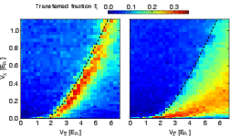 We report on the creation of Dirac points with adjustable properties in a tunable honeycomb optical lattice. Using momentum-resolved interband transitions, we observe a minimum band gap inside the Brillouin zone at the position of the Dirac points. We exploit the unique tunability of our lattice potential to adjust the effective mass of the Dirac fermions by breaking inversion symmetry. Moreover, changing the lattice anisotropy allows us to move the position of the Dirac points inside the Brillouin zone. When increasing the anisotropy beyond a critical limit, the two Dirac points merge and annihilate each other - a situation which has recently attracted considerable theoretical interest, but seems extremely challenging to observe in solids. We map out this topological transition in lattice parameter space and find excellent agreement with ab initio calculations.
We report on the creation of Dirac points with adjustable properties in a tunable honeycomb optical lattice. Using momentum-resolved interband transitions, we observe a minimum band gap inside the Brillouin zone at the position of the Dirac points. We exploit the unique tunability of our lattice potential to adjust the effective mass of the Dirac fermions by breaking inversion symmetry. Moreover, changing the lattice anisotropy allows us to move the position of the Dirac points inside the Brillouin zone. When increasing the anisotropy beyond a critical limit, the two Dirac points merge and annihilate each other - a situation which has recently attracted considerable theoretical interest, but seems extremely challenging to observe in solids. We map out this topological transition in lattice parameter space and find excellent agreement with ab initio calculations.
Read the paper: Nature 483 (2012)
Read the preprint: arXiv:1111.5020
☞ Lattice wiki
